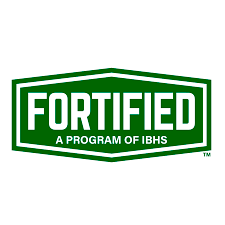
A soffit is the architectural term for the underside of any construction element. In residential buildings, it typically refers to the area that bridges the gap between a house’s siding and the roofline. When you look up at the eaves of your roof, the soffit is the horizontal section that you see.
The term “soffit” comes from the French word “soffite,” which means “formed as a ceiling” and its usage extends back to the Italian word “soffitto,” which means “ceiling.” In the context of home construction, soffits play a crucial role beyond just their appearance.
Functional Importance: The Role of Soffits in Home Design
Soffits serve several essential functions in home design, making them indispensable for both the practical and aesthetic upkeep of your house.
- Ventilation: One of the primary purposes of soffits is to ventilate the attic space. Proper ventilation helps to regulate the temperature in your attic, preventing heat buildup during summer and moisture buildup during winter. This is critical for maintaining the energy efficiency of your home and prolonging the life of your roof.
- Moisture Prevention: By providing ventilation, soffits also help to prevent moisture accumulation in the attic. Moisture can lead to mold growth and wood rot, which can compromise the structural integrity of your roof and home.
- Pest Deterrence: Soffits act as a barrier to pests such as birds, squirrels, and insects, preventing them from entering your attic and causing damage.
- Aesthetic Enhancement: From an aesthetic standpoint, soffits contribute to the finished look of your home. They cover the rafter tails and provide a seamless transition from the roof to the siding, enhancing curb appeal.
- Energy Efficiency: Properly ventilated soffits can also contribute to the energy efficiency of your home by reducing the load on your HVAC system. This can lead to lower energy bills and a more comfortable living environment.
Think of your attic as a vital organ of your house, like your lungs. Just as your lungs need to breathe to keep you healthy, your attic needs ventilation to maintain the health of your home. Soffits, often unnoticed, work tirelessly to ensure that airflow is maintained, moisture is controlled, and pests are kept out, much like a silent guardian protecting your home from unseen threats.
The Benefits of Having a Soffit
1. Protective Features: Shielding Your Home from the Elements
Soffits play a big role in protecting your home from environmental factors. By covering the exposed rafters and eaves, soffits prevent water from entering the structure of your house, which can lead to wood rot and structural damage. This protection extends to preventing snow, ice, and debris from accumulating in areas that could cause significant damage over time.
2. Aesthetic Value: Enhancing Your Home’s Appearance
Beyond their functional role, soffits add a polished, finished look to your home’s exterior. They cover unsightly rafters and eaves, creating a smooth transition between the roof and the walls. This not only improves the overall aesthetics but can also increase your home’s curb appeal, making it more attractive to potential buyers.
3. Ventilation and Airflow: Ensuring Proper Attic Ventilation
Proper attic ventilation is crucial for maintaining the health and efficiency of your home. Soffits facilitate this by allowing air to flow freely into the attic space. This airflow helps regulate temperatures, reducing the risk of ice dams in the winter and lowering cooling costs in the summer. It also helps to expel moist air, preventing mold growth and wood rot.
Imagine a scenario where your attic lacks proper ventilation. Over time, heat and moisture build-up, creating the perfect environment for mold and mildew. This can lead to significant health risks and costly repairs. Soffits, by ensuring continuous airflow, help to avert such hidden hazards and promote a healthy home environment.
4. Energy Efficiency: Lowering Your Energy Bills
By promoting better airflow and temperature regulation, soffits contribute to the overall energy efficiency of your home. They help keep your attic cool during the summer and prevent heat from escaping during the winter. This reduces the burden on your HVAC system, leading to lower energy bills and a more comfortable living space year-round.
5. Enhanced Home Value: Increasing Property Worth
Installing high-quality soffits can also have a positive impact on your home’s market value. Prospective buyers often look for homes with well-maintained and visually appealing exteriors. Soffits that are in good condition and complement the home’s design can significantly boost its attractiveness and, consequently, its value.
Material Choices: Common Soffit Materials
When it comes to selecting soffits, homeowners have several material options to consider, each with its own set of benefits and drawbacks. The most common materials include:
- Aluminum Soffit: Aluminum is a popular choice due to its durability and low maintenance. It is resistant to rot, insects, and weather damage. Aluminum soffits are also available in a variety of colors and styles, making them versatile for different home designs.
- Vinyl Soffit: Vinyl soffits are another favored option, known for their affordability and ease of installation. They are resistant to moisture and won’t peel, chip, or rot. Vinyl comes in various finishes and colors, allowing for customization to match your home’s exterior.
Pros and Cons: Advantages and Disadvantages of Popular Soffit Materials
Each material has its own set of pros and cons that can influence your decision:
Aluminum Soffit
- Pros:
- Durable and long-lasting
- Low maintenance
- Resistant to weather and pests
- Available in many colors and styles
- Cons:
- Can be more expensive than other materials
- Prone to denting if impacted by heavy objects
Vinyl Soffit
- Pros:
- Cost-effective and budget-friendly
- Easy to install and maintain
- Moisture-resistant
- Available in numerous colors and finishes
- Cons:
- Can become brittle in extremely cold weather
- Less durable than aluminum, susceptible to damage from impacts
Types of Soffit Vents: Continuous vs. Individual Vents
Proper ventilation is an obvious function of soffits, and there are different types of vents available to achieve this:
- Continuous Vents: These vents run the entire length of the soffit, providing consistent airflow throughout the attic. They are effective in maintaining even ventilation and are less likely to be obstructed by debris.
- Individual Vents: Also known as intermittent vents, these are spaced apart along the soffit. They can be a good option for specific ventilation needs but may require more maintenance to ensure each vent remains clear and functional.
Which Soffit Material is Best for You?
Choosing the right soffit material depends on various factors, including your budget, the climate you live in, and your maintenance preferences. Aluminum and vinyl are the most popular choices due to their durability and low maintenance requirements. Consider your specific needs and consult with a professional to determine which material will work best for your home.
Why Investing in a Quality Soffit Matters
Investing in high-quality soffits is essential for the long-term health and appearance of your home. Quality soffits provide better protection against weather and pests, require less maintenance, and can significantly enhance your home’s curb appeal. While it might be tempting to opt for cheaper materials, the benefits of investing in durable, well-made soffits far outweigh the initial cost savings.
Upkeep for Different Soffit Types
Proper maintenance of soffits ensures they continue to perform their protective and aesthetic functions effectively. Here are some maintenance tips for the most common soffit materials:
Aluminum Soffit
- Cleaning: Wash with a mild detergent and water to remove dirt and debris.
- Inspection: Regularly check for dents or damage, especially after storms or high winds.
- Repairs: Address any issues promptly to prevent further damage.
Vinyl Soffit
- Cleaning: Use a soft brush and soapy water to clean the surface, avoiding abrasive materials that could cause scratches.
- Inspection: Look for any signs of brittleness or cracking, particularly in colder climates.
- Repairs: Replace any damaged sections to maintain overall integrity.
Summary of Benefits
To recap, soffits are an indispensable part of your home’s exterior, providing critical ventilation, protection, and aesthetic benefits. They help to:
- Shield your home from environmental damage
- Enhance its visual appeal
- Promote energy efficiency by regulating attic temperature
- Increase your property’s market value
Think about a homeowner who invests in high-quality aluminum soffits and follows a fairly regular maintenance routine. Over the years, their home remains free from pest infestations, moisture damage, and extreme temperature fluctuations in the attic. This not only saves them money on repairs and energy bills, but it also boosts their home’s market value when it’s time to sell. Investing in quality soffits is a decision that pays off in both the short and long term.





